1/1/10 How much land did they tell you that turbine was going to take up? And how big and how deep did they say that base was going to be?
A word from our neighbors to the north about industrial scale wind turbine construction on farmland:
"Farmers, you are advised to check the facts."
[click here to read this at at source]
"Somewhere among the pie-in-the-sky claims made by Prowind about how the wind turbine developments will actually add to the bucolic nature of the rural landscape, is the statement that farmers can use their land right up to within a couple of feet of the base for each turbine, and that the base doesn’t take up much space.
 Here is a photo taken by the CBC of the base for a turbine being constructed right now near Harrow, Ontario. THAT is how big the base really is (some of it will be underground when they backfill the earth). This base is for a turbine that is 120 meters high—the ones planned for North Gower are much larger.
Here is a photo taken by the CBC of the base for a turbine being constructed right now near Harrow, Ontario. THAT is how big the base really is (some of it will be underground when they backfill the earth). This base is for a turbine that is 120 meters high—the ones planned for North Gower are much larger.
What are the effects on the water table of a thing like that?"
NOTE FROM THE BPWI RESEARCH NERD:
Why is turbine construction so hard on farmland?
For the construction of the 88 turbine Blue Sky, Green Field Industrial wind plant in Fond du Lac County, the construction period was estimated to last up to ten months. And during that ten months, it was estimated that residents would have to share the road with over 9,000 trucks and other heavy equipment.
They included
Excavators
Bulldozers
Graders
Water Trucks
Concrete pumps
Cranes
Forklifts
Trailers
Plows
Trenchers
5,000 Gravel Trucks,
2,750 Cement trucks
Nearly 200 low boy and flat bed semis
For a total of over 8,200 trucks for construction materials.
Add onto that 880 oversized truck loads for the turbine parts--
You get 9,000 heavy trucks coming in and 9,000 trucks rolling out.
The trucks carrying the turbine parts are larger and weigh more than standard size.
Now add the weight of the turbine components:
The tower weight over 140 tons
Hub assembly over 15 tons
Blades over 6 tons each
Nacelle containing gearbox and generator over 53 tons.
Such loads on cropland can cause severe compaction of soil.
Click here to see photos and read more about wind turbine construction on Wisconsin farm land.
12/31/09 Cash for Wind Leases: OR "I'll give you this big nickel for that little dime"
 Golden Opportunity or Another Green Cheese Sandwich?
Golden Opportunity or Another Green Cheese Sandwich?
Some say the success of the wind industry relies on empty cupboards in rural communities.
Struggling rural families who have signed on with wind developers now have a new industry to contend with, one that will pay out a lump sum in exchange for ownership of the wind lease and all that goes with it.
It reminds us of the many 'Check-into-Cash' or 'Payday Loans' stores that appear in blighted communities.
This quote is from an organization called "Wind Farm Capital" CLICK HERE to read at source
"Get an Upfront Lump Sum Cash Payment by Selling Wind Farm Lease"
"Financial Benefits of Selling Your Wind Farm Lease to Wind Farm Capital"
"In today’s economic climate, consumers and businesses alike are feeling the impact of the credit market squeeze, and finding it virtually impossible to secure capital, regardless of their credit history.
But Wind Farm Capital can provide a quick, easy, and welcome alternative by converting your wind farm lease royalties payment into a lump sum cash payment.
We provide the cash up front; there are no loan applications to fill out, no interest payments to budget for, and best of all, no default scenarios to worry about - no matter what happens to the lease down the road. Even if your lease terminates for some reason, you owe us nothing.
With multiple years’ worth of lease payments in your hands now, your options suddenly become endless. Whether you choose to pay down your existing debt, plan for your future, or invest in the market, the reward for each is similar - a windfall that leads to greater financial freedom, security, and long-term wealth."
NOTE FROM THE BPWI RESEARCH NERD: Please consult a lawyer before you sell your wind lease to anyone.
"By 2020, Xcel Energy [formerly Florida Power and Light] plans to more than double wind capacity system-wide from 2,800 megawatts to 7,000 megawatts.
Engelking said Xcel will buy or develop 3,000 megawatts of that power for its system in Minnesota or Wisconsin. She said the utility will focus on developing wind because tax benefits reduce energy costs to consumers."
NOTE FROM THE BPWI RESEARCH NERD: Wisconsin has just over 300 industrial scale turbines at present.
This proposal from Xcel for 3,000 megawatts of wind power requires the installation of at least two thousand 1.5MW turbines. Each turbine is close to 40 stories tall.
Xcel is not the only developer planning projects in our state. In order to meet the Governor's Task Force on Global warming recommendations, at least 14,000 more turbines need to be sited.
AND THE TURBINES JUST KEEP GETTING BIGGER
A new wind farm planned for the Town of Glenmore in Brown County calls for turbines 500 feet tall, or as tall as a 50 story building. This will make them the tallest structures in the state of Wisconsin.
WHO WILL OWN THE BROWN COUNTY WIND FARM?
WHO IS 'EMERGING ENERGIES OF WISCONSIN?'
"The CH Energy Group, owner of the New York utility Central Hudson Gas & Electric Corporation, holds a controlling interest in the project via its unregulated subsidiary Central Hudson Enterprises."
12/28/09 UPDATE on yesterday's turbine collapse: Another One Bites the Dust: What made turbine # 18 collapse?
Click on image below to watch an updated news report on the turbine collapse at the Fenner wind farm.
Turbine collapse draws concern from other proposed project areas
FENNER, N.Y. (WKTV) - Local residents are wondering if one wind turbine could collapse in Madison County, then it is very possible for a turbine to fall anywhere.
Fairfield resident Jim Salamone thinks why couldn't it happen in his back yard.
Salamone, who is opposed to the proposed wind turbine projects in Fairfield says he was not surprised when he woke up to find out a wind turbine had collapsed in Fenner. He says the meteorological tower that used to be right across from his home already collapsed because of wind and ice.
Meteorological towers are used to measure wind in areas where developers want to put turbines. Salamone says the meteorological tower that collapsed near his home was the third one to do so in as many years.
Salamone says he wonders if those towers can collapse so easily, and if a tall turbine can also collapse how safe is his property living so close to a proposed site.
"They must be 1250 feet from your house, 500 feet from the road. So if a 476 foot wind turbine comes down 500 feet from the road that is only going to leave you, what 24 feet (that) if the blade breaks that is has to travel before it could go through your car." said Salamone.
Salamone says he is not opposed to a wind turbine project if they are put in the right place, but he says the rolling hills near most homes in Fairfield, is not the right location for large turbines.
TURBINE FALLS AT FENNER WIND FARM
WSYR-TV [Click here to read at source and watch news clip]
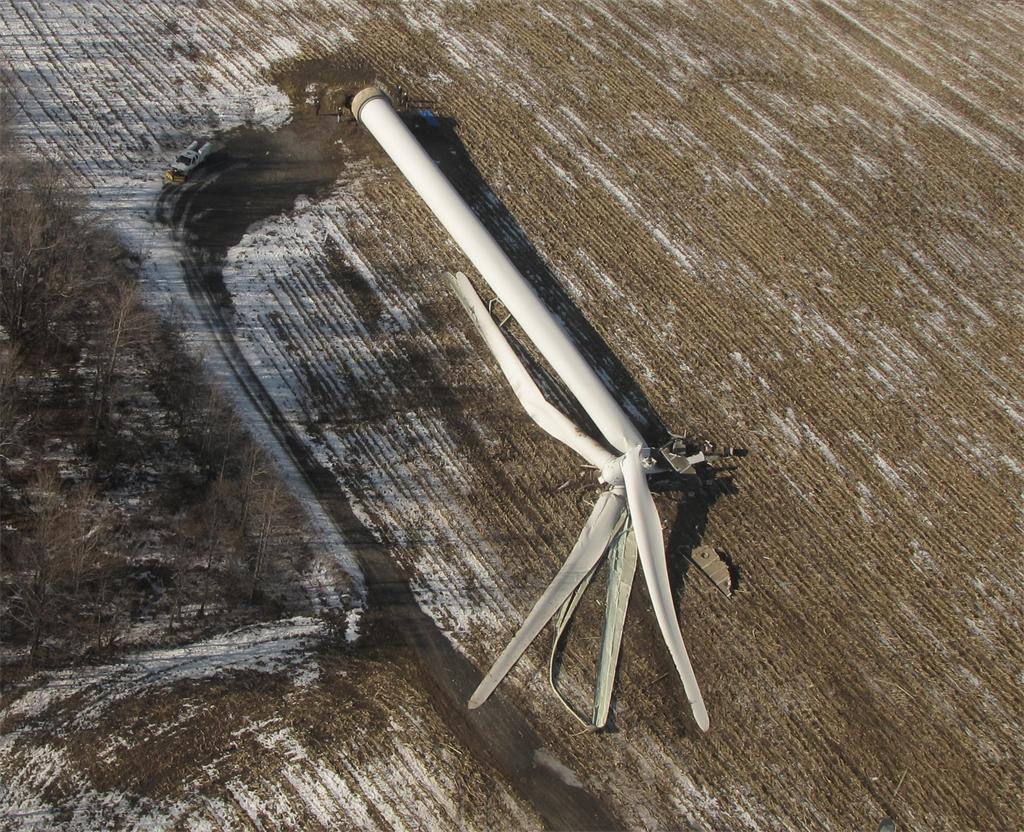
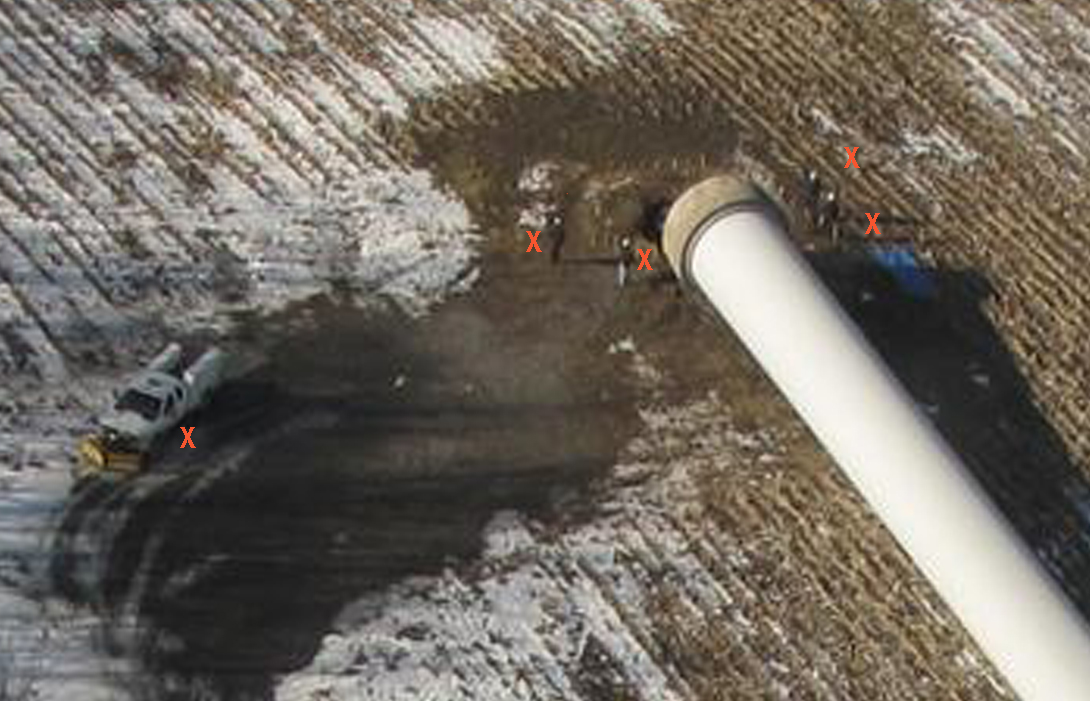
Fenner, Madison County (WSYR-TV) – A turbine at the Fenner wind farm has toppled, and engineers are on the scene trying to figure out how it happened.
The tower, which is more than 300 feet long from the base to the tip of the blade, is located just off Buyea Road, and is one of 20 generating electricity.
"I was turning over in bed and it sounded like a big clap of thunder" said Jill Van Allen, who lives across the street. "I was waiting to see the lightning through my bedroom window (but didn't)".
Fenner Town Supervisor Russ Cary was notified by company officials at Enel North America, which owns the farm. He tells us Enel did not have any answers as to how it happened, but adds, the towers were built a distance away from homes for this very reason-that if they collapse, they won't do any harm.
From another news story:
Officials investigating why 187 ton windmill collapsed in Fenner
QUOTE: "Bob Stinson, a resident of South Road nearly two miles from Turbine 18, said it sounded like "a sonic boom" when the windmill toppled.
"I felt it. It shook the house. It woke me up," Stinson said."
READ ENTIRE STORY BY CLICKING HERE
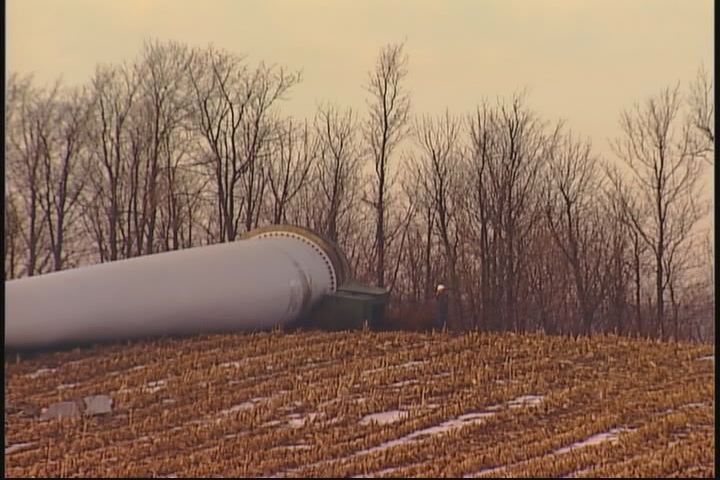
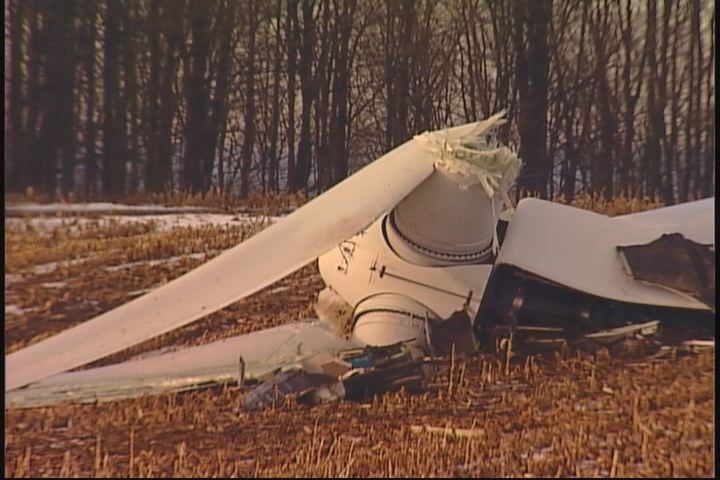
12/27/09 What is the effect of a wind farm on property values? A tale of two studies and a story problem
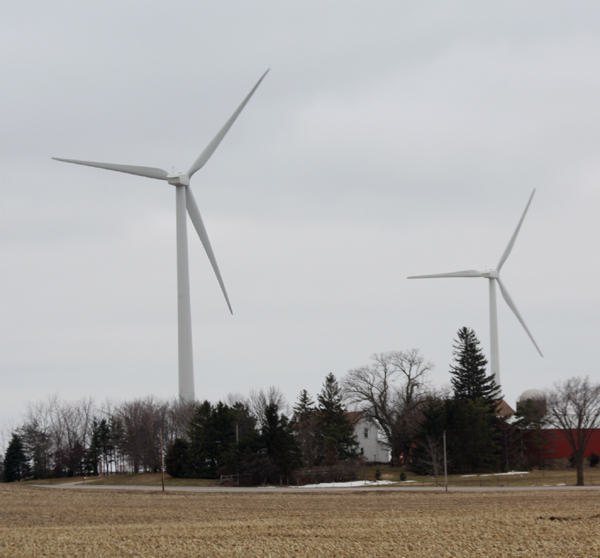
Turbine impact studies conflict
PROPERTY VALUES: Local opponents say wind farms harmful
Opponents of wind farm development in Jefferson County have touted property value decline as a possible harm.
But that argument, or any counterclaim, is getting little support from experts. Two studies on property values around wind farms were released in 2009, but had very different results.
The U.S. Department of Energy's Lawrence Berkeley National Laboratory supported a study that found no measurable value loss linked to wind farms in sales data from 7,459 sales of single-family homes within 10 miles of 24 wind farms in nine states.
Meanwhile, Appraisal Group One, Oshkosh, Wis., conducted a smaller study of vacant land sales in and around two wind farms for the Calumet County Citizens for Responsible Energy this year. In a year where property values suffered nationally, that study found the average loss in value at 40 percent in one wind project's area and 30 percent in the other.The Energy Department study, led by Ben Hoen, looked at home sales from 1996 to 2007. It compared the characteristics of the homes in several models.
"Specifically, neither the view of the wind facilities nor the distance of the home to those facilities is found to have any consistent, measurable and statistically significant effect on home sales prices," the report said.
The number of transactions, which included 125 within a mile after construction and about 60 within 3,000 feet, decreased the margin of error.
"It was more data than had been collected before," Mr. Hoen said. "We tried a lot of different ways of testing the data. It's the most complete analysis of the subject to date."
But Kurt C. Kielisch, president of Appraisal Group One, said the sheer number of sales included in the Energy Department study may have clouded the results.
"You can lose the distinction in numbers," he said. "You only need 20 to 30 good sales for a very good study."
His appraisal firm's study included sales of 12 vacant parcels inside two wind projects' boundaries and 90 vacant parcels outside the boundaries. All of the parcels were within one-half mile of turbines and had a view of them.
"It is logical to conclude that the factors that created the negative influence on vacant land are the same factors that will impact the improved property values," the study said. "Therefore, it is not a leap of logic to conclude that the impact of wind turbines to improved property value would also be negative."
Mr. Hoen said the Energy Department study has its advantage in the high number of sales included.
"In other studies the effect exists based on the surveys of Realtors," he said. "In our study, we concentrated only on actual transactions."
Appraisal Group One did include a survey of real estate agents. Mr. Kielisch argued that the results tracked very closely with his sales data.
"Every appraiser gets opinions from Realtors," Mr. Kielisch said. "They are in the trenches and we are the observers."
The survey asked about property value on parcels within 600 feet, 1,000 feet and one-half mile of the turbines. The agents agreed there would be lost value for all the lots, vacant or improved. How much, between 24 percent and 43 percent, depended on the distance.
Based on his results, Mr. Kielisch suggested that property owners ask for a property value assurance agreement, where a developer would pay the difference between a property's sale price and the value of comparable property outside of a wind power development if the property loses value.
"If you really believe that the value won't decline, guarantee that fact," he said.
Both researchers agreed future studies should include some data on how long properties are on the market. Other areas to consider include whether secondary residences and certain scenic vistas are more sensitive, Mr. Hoen said.
NOTE FROM THE BPWI RESEARCH NERD:
Story Problem: If the DOE report used sales data from 7,459 sales of single-family homes within 10 miles of 24 wind farms in nine states, and 125 of those homes were within a mile of the wind farm after construction and about 60 of those were within 3,000 feet, what percentage of the homes in this study are located within one mile of a wind farm?
ANSWER: 1.67 %
Extra Credit: What percentage of the homes in this study were located within 3000 feet?
ANSWER: 0.8 %
Extra extra credit: What is the setback from a home in Wisconsin?
ANSWER: 1000 feet or less.

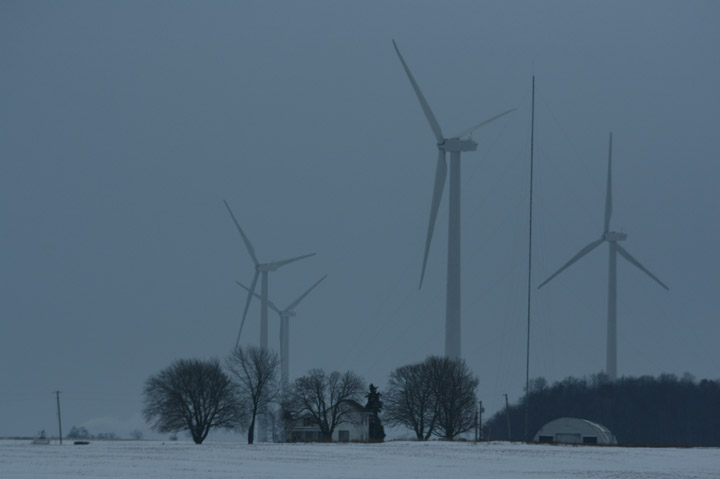
12/23/09 Christmas comes to those who fight to protect their communites
 SANTA VISITS ROCK COUNTY, WISCONSIN:
SANTA VISITS ROCK COUNTY, WISCONSIN:
Company representative confirms EcoEnergy is no longer a part of the EcoMagnolia project
In an email sent yesterday to Better Plan, Wisconsin, EcoEnergy confirmed they are no longer a part of developing a proposed wind farm for the Town of Magnolia. The project has been sold to Spanish wind developer, Acciona which now owns the lease agreements signed by landowners in the Towns of Magnolia and Union. Though the sale of the project took place over a year ago, EcoEnergy had stated they intended to stay with the project. What prompted EcoEnergy's decision to abandon the project is unknown.
Whether Acciona intends to build the wind farm with the land leases it now owns in Rock County, or or sell the leases to another buyer is also unknown.
Better Plan, Wisconsin has contacted Acciona's Chicago office to ask what the future plans are for the EcoMagnolia project but have yet to receive a reply.
The specific duration of the landowner lease/easements to land in Rock County which are now owned by Acciona is unknown. However, according to Windustry, "Wind leases and easements are often written to cover extremely long periods of time—30 to 60 years is common, and they can be longer than 150 years in some cases." [click here to read at source]
The original proposal called for 67 wind turbines, each as tall as a 40 story building, to be sited within the Town of Magnolia's 36 square miles.
The Town of Magnolia was the first Town in Rock County to adopt a large wind ordinance with a setback of 2640 feet from homes. Since then, four other Rock County towns have adopted a similar ordinance with the same setback. They are the Towns of Union, Janesville, Center and Spring Valley. All of the ordinances include a provision which allows a landowner to sign a waiver with the developer and the Town to have turbines closer to their homes if they wish.[Click here to download the Town of Union ordinance]
CLICK HERE TO READ ABOUT TURBINE NOISE AND HEALTH CONCERNS OVER ANOTHER ACCIONA PROJECT
NEXT: SANTA VISITS NEW ULM, MINNESOTA:

Early Christmas for farmers threatened with eminent domain for Minnesota wind power farm
Review Messenger www.reviewmessenger.com
Christmas came early this week for several Minnesota farmers when state regulators unanimously rejected a permit for a controversial wind farm proposed by the City of New Ulm, which had threatened to use eminent domain authority for the first time on record to seize the wind rights over the opponents’ property in order to force through the 8-megawatt project.
“It’s a first. They’ve has never denied a wind permit like this before,” said Jeff Franta, a farmer who helped organize the opposition. ”The city utility commission has the intimidating tool of eminent domain and doesn’t have to take ‘no’ for an answer and they didn’t. We’re not interested. It doesn’t belong out here.”
“This decision sends two important messages in our view,” said Annette Meeks, CEO of the Freedom Foundation of Minnesota. “First, rather than bullying landowners with eminent domain powers, city government utilities must work cooperatively with landowners the same as private developers do. Second, the current rush to install wind farms and other green energy projects does not trump private property rights.”
In a case that has attracted national attention among groups monitoring eminent domain takings, on December 21st the Minnesota Public Utilities Commission (PUC) voted 5-0 to deny the New Ulm Public Utilities Commission application to erect five wind turbines in rural Lafayette Township.
It is the first time the PUC has ever denied a permit for a wind farm project, a ruling that sends a clear signal to developers of “green energy” in Minnesota.
“There’s an expectation for these projects to move ahead with developers to engage the communities to get voluntary participation in these projects and land rights are a significant component in the commission’s assessment of a project’s viability,” said Bob Cupit, an expert with the PUC.
.
New Ulm had acquired easements for 237 acres to erect the turbines, but needed to obtain the wind rights to about 235 acres of adjacent property in the path of the prevailing winds to assure a free flow of wind to the turbines.
While public utilities have fairly broad powers to use government authority to force property owners to sell to meet their needs, experts said the New Ulm plan involved an unprecedented move to expand eminent domain authority to include the seizure of air space on private property for power generation.
In a July 30, 2009 filing with the PUC, Nierengarten, on behalf of the New Ulm Public Utilities Commission, insisted “the development of clean, renewable energy should be the motivating, prudent public policy consideration, not provincial notions of “local control” and the “rural way of life.”” If not, Nierengarten added, “it will be necessary for the City of New Ulm to exercise its powers of eminent domain to secure such rights and move this vital project forward.”
The opponents say they do not object to wind power per se, but have concerns about noise levels, lower property values, and the project’s adverse impact on the landscape and rural atmosphere.
“I think developers are going to pay attention to this and we’re not going to move too quickly with projects until a higher percentage of the land rights are acquired before they engage the formal proceedings for a permit,” said Cupit of the PUC .
Despite the ruling, neither side appears to consider the matter completely settled. New Ulm officials indicated they may continue to pursue the project. Opponents are already working with local legislators on draft legislation that would prevent other landowners from facing the same threat in the future.
“A public utility such as New Ulm cannot have that threat of eminent domain from the start,” said Franta. “Landowners should know from the start that they don’t have to be worried about losing their land unwillingly. Who wants to do business with someone who forces something onto you?”
The case comes at a critical time with Minnesota and the nation fast tracking green energy projects that are often fueled by federal grants, including billions in stimulus spending. Minnesota ranks fourth in overall wind production nationally with 1805 megawatts of wind-generated electrical capacity. Currently, approximately 21 wind energy projects and proposals are on the table statewide, according to the PUC.
A WARM, BRIGHT, HOPEFUL AND MERRY CHRISTMAS TO ALL FROM BETTER PLAN, WISCONSIN